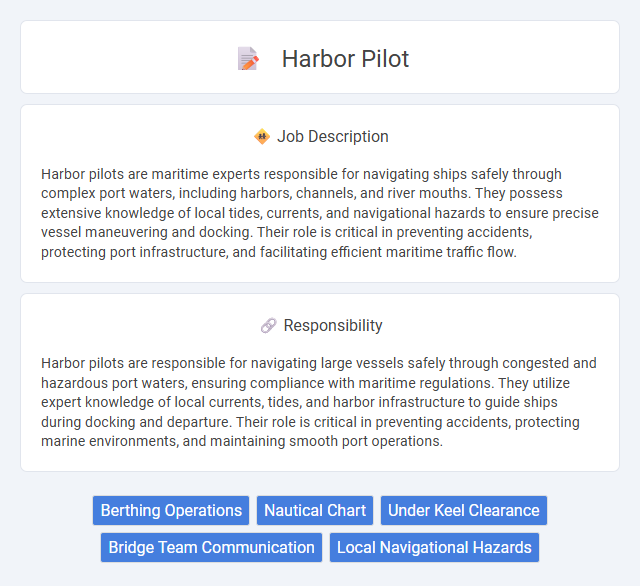
Harbor pilots are maritime experts responsible for navigating ships safely through complex port waters, including harbors, channels, and river mouths. They possess extensive knowledge of local tides, currents, and navigational hazards to ensure precise vessel maneuvering and docking. Their role is critical in preventing accidents, protecting port infrastructure, and facilitating efficient maritime traffic flow.
Harbor Pilots often face high-stress environments requiring quick decision-making and strong situational awareness, which suggests individuals with calm, focused personalities may be better suited for the role. Physical fitness and the ability to work irregular hours, including nights and weekends, likely increase the probability of job success. Those who thrive in dynamic, maritime settings and enjoy problem-solving under pressure are probably ideal candidates for this profession.
Qualification
Harbor pilots must possess extensive maritime knowledge, including a deep understanding of local waterways, tides, and weather conditions. Certification typically requires passing specialized exams and accumulating thousands of hours of experience as a licensed mariner. Strong decision-making skills, physical fitness, and precise navigation abilities are essential qualifications for ensuring vessel safety during complex port maneuvers.
Responsibility
Harbor pilots are responsible for navigating large vessels safely through congested and hazardous port waters, ensuring compliance with maritime regulations. They utilize expert knowledge of local currents, tides, and harbor infrastructure to guide ships during docking and departure. Their role is critical in preventing accidents, protecting marine environments, and maintaining smooth port operations.
Benefit
Harbor pilots likely offer substantial benefits including competitive salaries and comprehensive health insurance plans. They may also receive retirement benefits and paid time off, reflecting the demanding nature of navigating large vessels safely into port. Job security and specialized training opportunities probably enhance overall compensation and career satisfaction.
Challenge
Harbor pilot jobs likely present significant challenges due to navigating large vessels through confined waterways under varying weather conditions. The role demands sharp decision-making skills and deep knowledge of local maritime environments to minimize risks and ensure safe passage. High stress levels and responsibility for vessel and crew safety probably make this career both demanding and rewarding.
Career Advancement
Harbor Pilot careers offer significant opportunities for advancement through specialized training and certification, leading to senior pilot or port management roles. Expertise in navigation, local maritime regulations, and vessel handling enhances prospects for increased responsibility and higher remuneration. Continuous professional development and experience in diverse port conditions are critical for progressing to leadership positions within the maritime industry.
Key Terms
Berthing Operations
Harbor pilots possess expert knowledge of local waterways and are essential for safe berthing operations, expertly maneuvering vessels through narrow channels and busy ports. They coordinate closely with tugboats, port authorities, and ship crews to ensure precise docking and minimize risks during the berthing process. Their role significantly reduces the chance of collisions, groundings, and delays, optimizing port efficiency and maritime safety.
Nautical Chart
Harbor pilots rely heavily on detailed nautical charts to navigate ships safely through complex port waters, avoiding hazards such as shallow depths, rocks, and underwater obstructions. These charts provide critical information including water depths, tidal data, navigational aids, and port layouts, enabling pilots to make precise decisions during berthing and departure. Mastery of nautical chart interpretation ensures effective ship handling and minimizes risks in confined harbor channels.
Under Keel Clearance
Harbor pilots expertly navigate vessels through confined waterways, ensuring safe passage by closely monitoring Under Keel Clearance (UKC) to prevent grounding. Precise calculation of UKC involves considering tidal variations, vessel draft, and seabed topography to maintain optimal safety margins. Advanced sonar and real-time depth measurement technologies assist pilots in adjusting navigation strategies, enhancing vessel safety and operational efficiency within port approaches.
Bridge Team Communication
Effective bridge team communication is critical for harbor pilots to ensure safe and precise navigation in congested port waters. Harbor pilots coordinate closely with the ship's captain, engine room, and deck crew, using clear, concise verbal and non-verbal signals to manage vessel movements and avoid collisions. Mastery of standardized maritime communication protocols, such as Bridge Resource Management (BRM), enhances situational awareness and decision-making during complex maneuvers.
Local Navigational Hazards
Harbor pilots possess expert knowledge about local navigational hazards including shifting sandbars, strong tidal currents, and underwater obstructions that pose risks to large vessels. They utilize detailed charts, real-time weather data, and local maritime conditions to guide ships safely through narrow channels and congested port areas. Mastery of these hazards minimizes the risk of groundings and collisions, ensuring efficient and secure harbor navigation.
 kuljobs.com
kuljobs.com